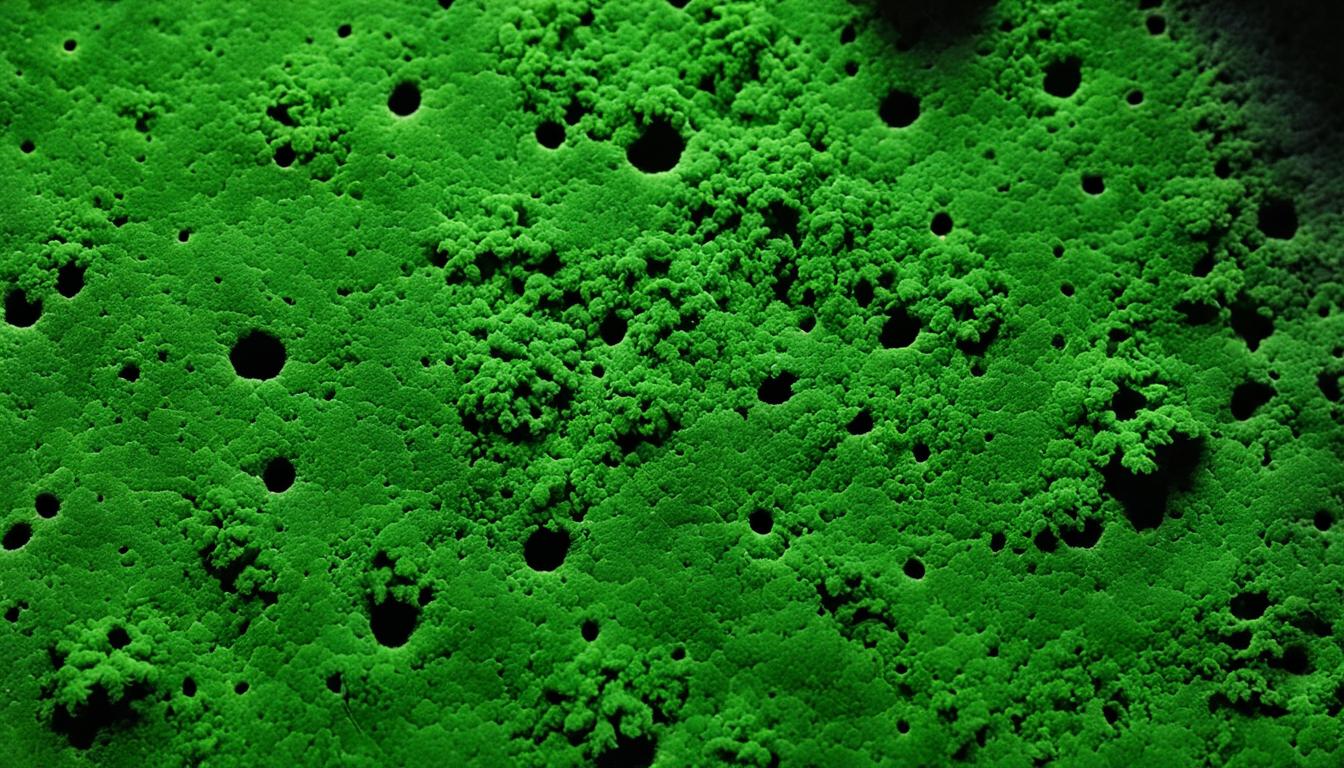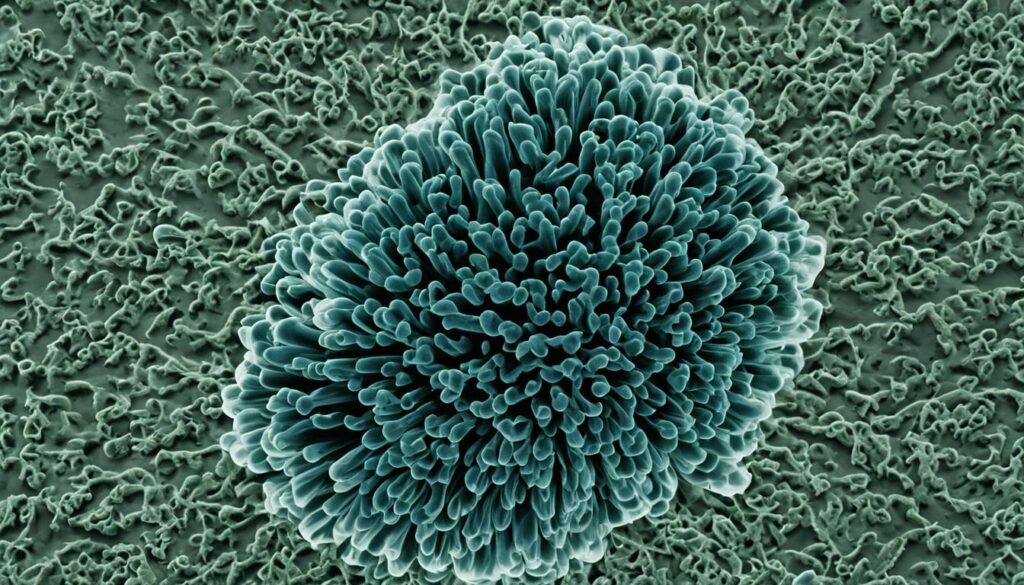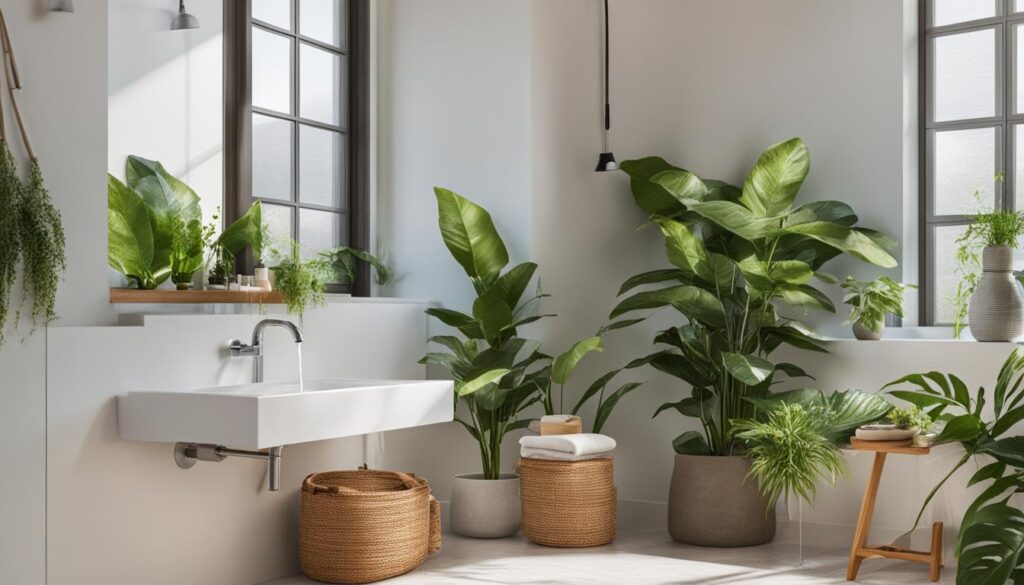
Alternaria Mold Exposure Risks & Prevention Tips
Have you noticed a musty odor in your home or workplace that just won’t go away? Or have you been experiencing symptoms like a runny nose, sneezing, coughing, or itchy eyes that seem to come and go? These could be signs of household mold, particularly, alternaria mold, one of the most common types of mold found indoors. Alternaria mold not only affects the structure of buildings but can be hazardous to human health, especially for those with allergies and respiratory issues.
In this section, we will discuss the risks associated with exposure to alternaria mold and provide effective tips for prevention. It’s essential to stay informed and take the necessary steps to protect yourself and those around you from the potential dangers of indoor mold.
Key Takeaways:
- Alternaria mold is a common type of household mold that can cause health problems, particularly for individuals with allergies and respiratory issues.
- Exposure to alternaria mold can lead to symptoms like a runny nose, coughing, wheezing, and itchy eyes.
- Preventing alternaria mold growth requires controlling moisture and humidity levels, ensuring proper ventilation, and promptly addressing any leaks or water damage.
- Professional mold inspections are crucial for identifying and addressing mold issues effectively.
- Maintaining good indoor air quality is key to minimizing the presence of mold spores and preventing mold-related health issues.
Understanding Alternaria Mold
Alternaria mold is a common household mold that can have a significant impact on your health. It typically grows in damp areas, such as bathrooms, basements, and kitchens, and can spread quickly if left untreated. Mold spores are the primary causes of the spread of alternaria mold throughout the home and can easily contaminate the air, leading to respiratory problems for individuals with allergies or weakened immune systems.
At FixMold, our experts have years of experience in identifying and addressing mold issues, including alternaria mold. We will work with you to develop a comprehensive plan for preventing mold growth and improving indoor air quality in your home. Contact us at 305-465-6653 to learn more.
Common Symptoms of Alternaria Mold Exposure
Exposure to alternaria mold can cause a range of symptoms in individuals who are sensitive to mold spores. These symptoms can range from mild to severe and may include:
- Respiratory irritation: Alternaria mold can cause inflammation in the respiratory system, leading to coughing, wheezing, and shortness of breath.
- Nasal congestion: Mold spores can cause irritation in the nasal passages, leading to stuffy or runny nose.
- Eye irritation: Exposure to mold spores can cause red, itchy, or watery eyes.
- Skin irritation: Alternaria mold can cause skin irritation in some individuals.
Prolonged exposure to mold spores can also lead to more severe symptoms, such as respiratory infections, allergies, and asthma. Additionally, poor indoor air quality can aggravate existing respiratory conditions, such as COPD and emphysema.
To reduce the risk of mold-related health issues, it’s crucial to address mold problems promptly and maintain good indoor air quality. In the next section, we’ll explore the specific health hazards associated with exposure to alternaria mold.
Health Hazards of Alternaria Mold Exposure
Exposure to alternaria mold can have severe implications on one’s health. The mold spores are known to cause respiratory issues, such as asthma attacks, allergic rhinitis, and hypersensitivity pneumonitis. Individuals with weakened immune systems, such as the elderly and young children, are more vulnerable to the effects of mold exposure. Prolonged exposure may also lead to the development of fungal infections, including sinusitis and invasive aspergillosis.
It’s crucial to address any mold issues promptly to avoid potential complications. Proper remediation measures, including controlling moisture and ensuring proper ventilation, can help prevent the spread of mold spores and minimize the risks associated with exposure.

In cases of significant mold contamination, it’s best to seek the assistance of professional remediation companies. These experts have the expertise and equipment to address mold issues safely and effectively, minimizing the health risks associated with exposure.
Identifying Alternaria Mold in Your Home
While mold growth is a common occurrence in households, identifying the type of mold present can be challenging. Alternaria mold is a type of household mold that can cause respiratory issues, so it’s essential to recognize it and distinguish it from other types like black mold.
So, how do you recognize alternaria mold?
| Alternaria Mold | Black Mold |
|---|---|
| Color ranges from greenish-black to brown | Black or dark green appearance |
| Can appear on damp surfaces such as showers, sinks, and window sills | Typically found in dark, damp areas such as basements or attics |
| Irregularly shaped lesions with woolly or downy texture | Often appears with a slimy texture |
If you suspect you have alternaria mold in your home, it’s essential to schedule a professional mold inspection to confirm the diagnosis. A mold inspector can identify the type of mold present, assess the extent of the infestation, and recommend appropriate action. Quick identification and intervention can prevent the mold from spreading and causing additional health risks.
Preventing Alternaria Mold Growth
Preventing alternaria mold growth in your home is vital to safeguard your health and maintain optimal indoor air quality. Alternaria mold is a common household mold that can cause adverse health effects. Fortunately, implementing these effective tips and strategies can minimize the likelihood of growth:
- Control moisture: Alternaria mold thrives in moist environments. Fix any leaks, dry wet areas promptly, and ensure proper ventilation in high humidity areas such as bathrooms and kitchens.
- Monitor humidity: Use a hygrometer to monitor humidity levels, and keep them between 30-50%. Consider using a dehumidifier if levels are consistently high.
- Proper ventilation: Ensure proper air circulation in your home by using exhaust fans, opening windows, and maintaining clean air ducts. This helps to prevent mold growth and improve indoor air quality.
- Regular cleaning: Clean and disinfect surfaces regularly to prevent the buildup of mold spores. Pay special attention to areas such as bathrooms, kitchens, and basements.
By following these tips, you can significantly reduce your risk of alternaria mold growth. Remember, early detection and proactive measures are key to preventing mold-related health issues.
Controlling Moisture and Humidity Levels
To prevent household mold, controlling moisture and humidity levels is crucial. Mold thrives in moist environments, making it essential to maintain a dry and well-ventilated home. Here are some practical mold prevention tips:
- Use a dehumidifier: Consider investing in a high-quality dehumidifier to keep humidity levels below 60%. This will reduce the risk of mold growth and improve indoor air quality.
- Fix leaks: Leaks in pipes, roofs, and windows can lead to excess moisture buildup, creating a breeding ground for mold. Regularly check for any leaks and fix them immediately to prevent mold growth.
- Use exhaust fans: Exhaust fans in bathrooms and kitchens help to remove excess moisture from the air. Make sure to run them for at least 30 minutes after showers or cooking to keep humidity levels under control.
- Avoid carpeting: Carpeting can trap moisture and humidity, making it a prime location for mold growth. If possible, choose hard flooring surfaces instead.
- Clean and dry surfaces: Regularly clean and dry surfaces, especially in areas with high humidity, such as bathrooms and kitchens. This will help prevent moisture buildup and minimize the risk of mold growth.
By following these mold prevention tips, you can effectively control moisture and humidity levels in your home, reducing the risk of mold growth and improving indoor air quality.

Addressing Mold Issues: Removal and Remediation
If you’ve discovered household mold, it’s crucial to address the issue promptly to protect your health and prevent further damage. Mold removal and remediation can be a complicated process, and it’s essential to understand the potential risks associated with DIY cleanup. In many cases, it’s best to seek professional help to ensure the issue is resolved effectively and according to industry standards.
Professional mold cleanup companies like CleanMold have the necessary expertise and equipment to safely and efficiently remove mold from your home. During the process, they will identify the source of moisture causing the mold growth and create a plan for remedying the issue to prevent future mold problems. They can also ensure that mold spores are not spread throughout your home, which can worsen indoor air quality and lead to respiratory issues.
When choosing a mold removal company, it’s essential to select a reputable and experienced provider. Look for companies that have been in business for several years and have positive customer reviews. Additionally, make sure the company is licensed and insured to protect yourself from any potential liability.
Mold Cleanup Comparison: DIY vs. Professional
| DIY Cleanup | Professional Cleanup | |
|---|---|---|
| Cost | Less expensive, but may end up costing more in the long run if not done properly | More expensive, but provides a thorough and effective solution |
| Time | May take longer to clean up and may not completely remove mold | Can complete the cleanup and remediation process more quickly and efficiently |
| Risk of Exposure | High risk of exposure to mold and its harmful effects | Minimal risk of exposure when using proper protective equipment and following safety protocols |
| Knowledge and Expertise | Requires a basic understanding of mold and cleaning techniques | Professional teams have specialized knowledge and expertise, ensuring proper identification, removal, and remediation |
Ultimately, the decision whether to handle mold cleanup yourself or hire professionals will depend on the severity of the problem and your budget. However, keep in mind that professional mold removal is generally the most effective and safest solution.
Improving Indoor Air Quality
The presence of mold spores can significantly impact indoor air quality and pose health risks. It is therefore crucial to establish good air quality standards in your home to minimize the presence of mold spores, especially of alternaria mold.
One effective way to achieve this is by improving ventilation. Adequate ventilation ensures that fresh air continually circulates, reducing moisture buildup and thus limiting mold growth. Open windows regularly, install vents in bathrooms and kitchens, and use exhaust fans when cooking or showering to maintain good air quality. You may also consider investing in air purifiers and dehumidifiers, which help regulate humidity levels and filter the air of impurities.
In addition to improving ventilation, it is essential to ensure that your air conditioning and heating systems are regularly maintained. Change filters on a regular basis and have the system inspected annually to avoid clogged filters that can interfere with optimal air filtration.
By incorporating these strategies, you can minimize the risk of mold spores in your indoor environment and ensure good indoor air quality. The presence of mold spores can go undetected, so it is essential to seek professional help from a qualified mold inspector if you suspect mold issues. Prioritizing indoor air quality is key to safeguarding your family’s health and well-being.
The Role of Professional Mold Inspections
Professional mold inspections are crucial for identifying and addressing household mold effectively. While there are various DIY methods to remove mold, only experts can provide comprehensive inspections to accurately detect the extent of the problem and suggest appropriate solutions. Mold inspection specialists are trained to recognize different types of mold, including the deadly black mold, which is often difficult to distinguish from other mold species.
Black mold exposure can cause serious health problems, including chronic respiratory issues, allergies, and even neurological damage. Efficient detection and removal of black mold require specialized knowledge, tools, and safety equipment for effective mold cleanup. That’s why it’s essential to hire professionals to inspect and remove hazardous mold growth.
Professional mold inspections are the first step in ensuring a mold-free and safe living environment. Experts can locate mold growth even in hidden areas and advise homeowners on the best approach to removing it. By hiring professionals for mold inspections, homeowners can avoid the potential risks associated with DIY methods that could make the problem worse.
| Mold Inspection Benefits | |
|---|---|
|
Conclusion
As we have seen, exposure to alternaria mold can pose significant health risks, which is why it is essential to take proactive measures to prevent it. By implementing simple mold prevention tips such as controlling moisture and humidity levels, improving indoor air quality, and seeking professional assistance, you can safeguard your home and minimize the risk of mold-related health issues. Remember, early detection and quick action are key to preventing household mold problems from spiraling out of control.
Contact FixMold at 305-465-6653 for expert mold assessments, prevention, and remediation services. Our experienced professionals can help you identify and address mold issues effectively, ensuring your home remains mold-free and your indoor air quality stays optimal. Don’t let mold put your health at risk – take action today to keep your home safe and healthy.
Keywords: alternaria mold, mold prevention tips, household mold, indoor air quality
FAQ
What is alternaria mold?
Alternaria mold is a common type of mold that can grow in homes. It is often found in areas with high moisture levels, such as bathrooms, kitchens, and basements. Alternaria mold can be identified by its dark green or black color and a fuzzy or velvety texture.
What are the risks of exposure to alternaria mold?
Exposure to alternaria mold can cause various health issues, especially in individuals with respiratory conditions or weakened immune systems. Common symptoms include sneezing, coughing, wheezing, nasal congestion, and skin irritation. Prolonged exposure can lead to more severe respiratory problems and allergic reactions.
How can I prevent alternaria mold growth in my home?
To prevent alternaria mold growth, it is crucial to control moisture levels in your home. This can be achieved by fixing any water leaks, using dehumidifiers in damp areas, and ensuring proper ventilation throughout the house. Regular cleaning and maintenance, especially in moisture-prone areas, can also help prevent mold growth.
Can I remove alternaria mold myself?
Small-scale mold cleanup can be done by homeowners using the appropriate safety precautions and cleaning products. However, it is advisable to seek professional assistance, especially for larger or more severe mold infestations, as improper removal can result in the spread of mold spores and potential health risks.
What should I do if I suspect alternaria mold in my home?
If you suspect alternaria mold in your home, it is essential to schedule a professional mold inspection. Trained specialists can assess the extent of the mold problem, identify the type of mold present, and recommend the appropriate remediation steps for safe and effective mold removal.
How does alternaria mold affect indoor air quality?
Alternaria mold releases spores into the air, which can negatively impact indoor air quality. Inhaling these mold spores can trigger allergic reactions and respiratory issues, particularly in individuals with pre-existing sensitivities. Maintaining good ventilation and utilizing air purifiers can help improve indoor air quality and reduce mold spore concentration.
Are all types of mold harmful to health?
While some types of mold are more hazardous than others, all molds can potentially cause health problems if exposure is prolonged or excessive. It is crucial to address any mold issues promptly and take preventive measures to maintain a healthy living environment.
When should I consider a professional mold inspection?
It is advisable to consider a professional mold inspection if you suspect a significant mold problem, notice persistent mold growth, or experience unexplained health symptoms that may be related to mold exposure. Professional inspectors have the necessary expertise to identify hidden mold sources and provide appropriate recommendations for remediation.
Can alternaria mold grow in areas other than homes?
Yes, alternariamold can grow in various indoor and outdoor environments. Besides homes, it is commonly found in decaying vegetation, soil, plants, and agricultural crops. High humidity levels, moisture, and warm temperatures favor its growth and spread.




